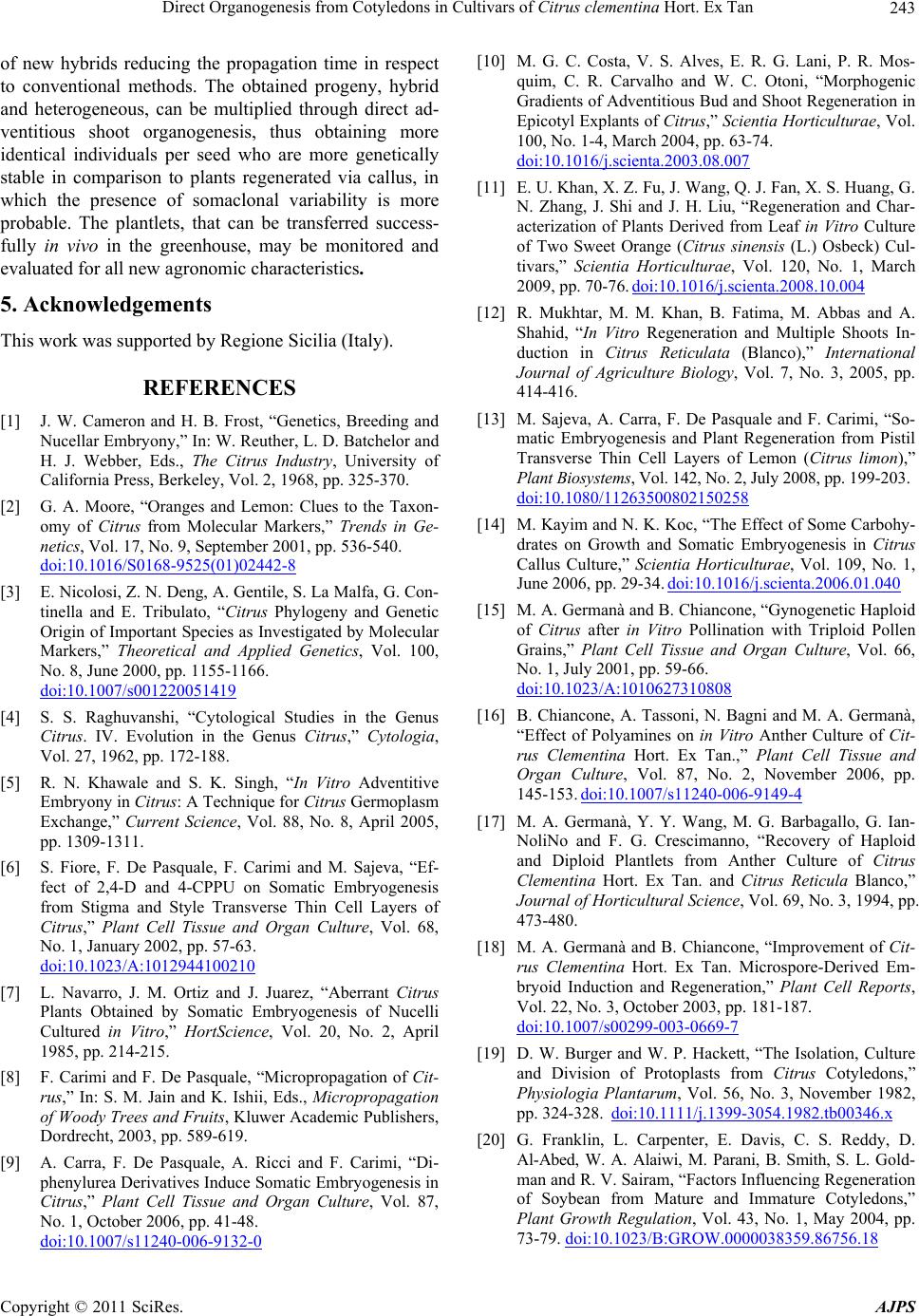
Direct Organogenesis from Cotyledons in Cultivars of Citrus clementina Hort. Ex Tan243
of new hybrids reducing the propagation time in respect
to conventional methods. The obtained progeny, hybrid
and heterogeneous, can be multiplied through direct ad-
ventitious shoot organogenesis, thus obtaining more
identical individuals per seed who are more genetically
stable in comparison to plants regenerated via callus, in
which the presence of somaclonal variability is more
probable. The plantlets, that can be transferred success-
fully in vivo in the greenhouse, may be monitored and
evaluated for all new agronomic characteristics.
5. Acknowledgements
This work was supported by Regione Sicilia (Italy).
REFERENCES
[1] J. W. Cameron and H. B. Frost, “Genetics, Breeding and
Nucellar Embryony,” In: W. Reuther, L. D. Batchelor and
H. J. Webber, Eds., The Citrus Industry, University of
California Press, Berkeley, Vol. 2, 1968, pp. 325-370.
[2] G. A. Moore, “Oranges and Lemon: Clues to the Taxon-
omy of Citrus from Molecular Markers,” Trends in Ge-
netics, Vol. 17, No. 9, September 2001, pp. 536-540.
doi:10.1016/S0168-9525(01)02442-8
[3] E. Nicolosi, Z. N. Deng, A. Gentile, S. La Malfa, G. Con-
tinella and E. Tribulato, “Citrus Phylogeny and Genetic
Origin of Important Species as Investigated by Molecular
Markers,” Theoretical and Applied Genetics, Vol. 100,
No. 8, June 2000, pp. 1155-1166.
doi:10.1007/s001220051419
[4] S. S. Raghuvanshi, “Cytological Studies in the Genus
Citrus. IV. Evolution in the Genus Citrus,” Cytologia,
Vol. 27, 1962, pp. 172-188.
[5] R. N. Khawale and S. K. Singh, “In Vitro Adventitive
Embryony in Citrus: A Technique for Citrus Germoplasm
Exchange,” Current Science, Vol. 88, No. 8, April 2005,
pp. 1309-1311.
[6] S. Fiore, F. De Pasquale, F. Carimi and M. Sajeva, “Ef-
fect of 2,4-D and 4-CPPU on Somatic Embryogenesis
from Stigma and Style Transverse Thin Cell Layers of
Citrus,” Plant Cell Tissue and Organ Culture, Vol. 68,
No. 1, January 2002, pp. 57-63.
doi:10.1023/A:1012944100210
[7] L. Navarro, J. M. Ortiz and J. Juarez, “Aberrant Citrus
Plants Obtained by Somatic Embryogenesis of Nucelli
Cultured in Vitro,” HortScience, Vol. 20, No. 2, April
1985, pp. 214-215.
[8] F. Carimi and F. De Pasquale, “Micropropagation of Cit-
rus,” In: S. M. Jain and K. Ishii, Eds., Micropropagation
of Woody Trees and Fruits, Kluwer Academic Publishers,
Dordrecht, 2003, pp. 589-619.
[9] A. Carra, F. De Pasquale, A. Ricci and F. Carimi, “Di-
phenylurea Derivatives Induce Somatic Embryogenesis in
Citrus,” Plant Cell Tissue and Organ Culture, Vol. 87,
No. 1, October 2006, pp. 41-48.
doi:10.1007/s11240-006-9132-0
[10] M. G. C. Costa, V. S. Alves, E. R. G. Lani, P. R. Mos-
quim, C. R. Carvalho and W. C. Otoni, “Morphogenic
Gradients of Adventitious Bud and Shoot Regeneration in
Epicotyl Explants of Citrus,” Scientia Horticulturae, Vol.
100, No. 1-4, March 2004, pp. 63-74.
doi:10.1016/j.scienta.2003.08.007
[11] E. U. Khan, X. Z. Fu, J. Wang, Q. J. Fan, X. S. Huang, G.
N. Zhang, J. Shi and J. H. Liu, “Regeneration and Char-
acterization of Plants Derived from Leaf in Vitro Culture
of Two Sweet Orange (Citrus sinensis (L.) Osbeck) Cul-
tivars,” Scientia Horticulturae, Vol. 120, No. 1, March
2009, pp. 70-76. doi:10.1016/j.scienta.2008.10.004
[12] R. Mukhtar, M. M. Khan, B. Fatima, M. Abbas and A.
Shahid, “In Vitro Regeneration and Multiple Shoots In-
duction in Citrus Reticulata (Blanco),” International
Journal of Agriculture Biology, Vol. 7, No. 3, 2005, pp.
414-416.
[13] M. Sajeva, A. Carra, F. De Pasquale and F. Carimi, “So-
matic Embryogenesis and Plant Regeneration from Pistil
Transverse Thin Cell Layers of Lemon (Citrus limon),”
Plant Biosystems, Vol. 142, No. 2, July 2008, pp. 199-203.
doi:10.1080/11263500802150258
[14] M. Kayim and N. K. Koc, “The Effect of Some Carbohy-
drates on Growth and Somatic Embryogenesis in Citrus
Callus Culture,” Scientia Horticulturae, Vol. 109, No. 1,
June 2006, pp. 29-34. doi:10.1016/j.scienta.2006.01.040
[15] M. A. Germanà and B. Chiancone, “Gynogenetic Haploid
of Citrus after in Vitro Pollination with Triploid Pollen
Grains,” Plant Cell Tissue and Organ Culture, Vol. 66,
No. 1, July 2001, pp. 59-66.
doi:10.1023/A:1010627310808
[16] B. Chiancone, A. Tassoni, N. Bagni and M. A. Germanà,
“Effect of Polyamines on in Vitro Anther Culture of Cit-
rus Clementina Hort. Ex Tan.,” Plant Cell Tissue and
Organ Culture, Vol. 87, No. 2, November 2006, pp.
145-153. doi:10.1007/s11240-006-9149-4
[17] M. A. Germanà, Y. Y. Wang, M. G. Barbagallo, G. Ian-
NoliNo and F. G. Crescimanno, “Recovery of Haploid
and Diploid Plantlets from Anther Culture of Citrus
Clementina Hort. Ex Tan. and Citrus Reticula Blanco,”
Journal of Horticultural Science, Vol. 69, No. 3, 1994, pp.
473-480.
[18] M. A. Germanà and B. Chiancone, “Improvement of Cit-
rus Clementina Hort. Ex Tan. Microspore-Derived Em-
bryoid Induction and Regeneration,” Plant Cell Reports,
Vol. 22, No. 3, October 2003, pp. 181-187.
doi:10.1007/s00299-003-0669-7
[19] D. W. Burger and W. P. Hackett, “The Isolation, Culture
and Division of Protoplasts from Citrus Cotyledons,”
Physiologia Plantarum, Vol. 56, No. 3, November 1982,
pp. 324-328. doi:10.1111/j.1399-3054.1982.tb00346.x
[20] G. Franklin, L. Carpenter, E. Davis, C. S. Reddy, D.
Al-Abed, W. A. Alaiwi, M. Parani, B. Smith, S. L. Gold-
man and R. V. Sairam, “Factors Influencing Regeneration
of Soybean from Mature and Immature Cotyledons,”
Plant Growth Regulation, Vol. 43, No. 1, May 2004, pp.
73-79. doi:10.1023/B:GROW.0000038359.86756.18
Copyright © 2011 SciRes. AJPS